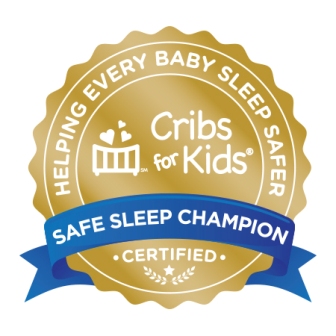Safe Sleep
Ensuring your baby sleeps safely

Sudden Infant Death Syndrome (SIDS) is the leading cause of death among infants between 1 month and 1 year of age. It is important to make sure you help your baby sleep safely to reduce your baby’s risk of SIDS. A safe sleep environment is recommended by the American Academy of Pediatrics.*
To create a safe sleep environment:
- To reduce the risk of SIDS, women should:
- Get regular prenatal care during pregnancy.
- Avoid smoking, drinking alcohol, and using marijuana or illegal drugs during pregnancy or after the baby is born.
- Do not smoke during pregnancy and do not smoke or allow smoking around your baby or in your baby’s environment.
- Supervised skin to skin is recommended to all mothers and babies immediately following birth regardless of feeding or delivery (as soon as mother is medically stable, awake and able to respond to her baby) and should continue for at least an hour – once mother starts to get sleepy, move baby to bassinet or another awake adult.
- Always place baby on his or her back to sleep, for naps and at night, to reduce the risk of SIDS.
- Baby should not sleep in an adult bed, on a couch, or on a chair alone, with you, or with anyone else.
- Breastfeed your baby to reduce the risk of SIDS. Breastfeeding has many health benefits for mother and baby. If you fall asleep while feeding or comforting baby in an adult bed, place him or her back in a separate sleep area as soon as you wake up.
- Use a firm and flat sleep surface, such as a mattress in a safety-approved crib, covered by a fitted sheet with no other bedding or soft items in the sleep area. A crib, bassinet, portable crib, or play yard that follows the safety standards of the consumer Product Safety Commission is recommended.
- Share your room with baby. Keep baby in your room close to your bed, but on a separate surface designed for infants, ideally for baby’s first year, but at least for the first 6 months.
- Do not put soft objects, pillows, toys, crib bumpers, or loose bedding under baby, over baby, or anywhere in baby’s sleep area.
- Do not let your baby get too hot during sleep.
- Dress your baby in sleep clothing, such as a wearable blanket. Do not use a loose blanket, and do not over bundle.
- Think about giving your baby a pacifier for naps and nighttime sleep to reduce the risk of SIDS. Wait until breastfeeding is well established (often by 3 to 4 weeks) before offering a pacifier.
- Follow guidance from your health care provider on your baby’s vaccines and regular health checkups.
- Avoid products that go against safe sleep recommendations, especially those that claim to prevent or reduce the risk for SIDS such as wedges, positioners, products made to have baby sleep in the adult bed, etc.
- Don’t use sitting devices like bouncy seats, swings, infant carriers or strollers for routine sleep.
- Do not use heart or breathing monitors in the home to reduce the risk of SIDS.
- Give your baby plenty of tummy time when he or she is awake and someone is watching.
Safe Sleep Photo Examples can be found here:Safe Sleep and Breastfeeding Image Gallery | NICHQ - National Institute for Children's Health Quality.